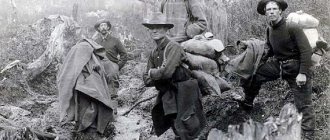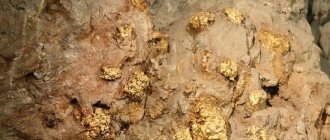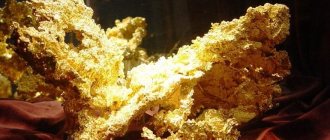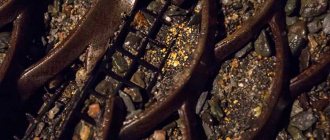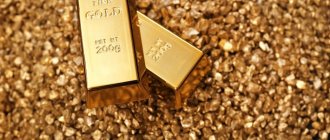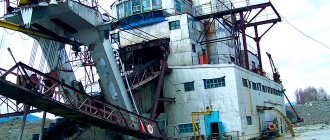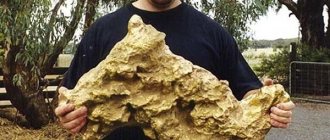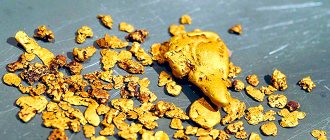Not only legends, but also historical facts claim that in the old days gold mining was quite active in the Moscow region: maps of deposits, preserved since then in various versions, still attract the darlings of fortune and gambling adventurers.
The gold rush at different times alternately covered the vast expanses of Russia. Gold panning began in a variety of regions, and often such enterprises achieved very significant success. And this is not surprising, because the Russian subsoil contains almost the entire periodic table, including precious metals. From time immemorial, miners in Rus' washed gold, which was more than enough for jewelry for the royal families, for precious church utensils and frames for icons, for minting coins and even for trade with close and distant neighbors.
Today, there are several hundred large and small deposits of this noble metal in the country. The Krasnoyarsk Territory, Chukotka, Yakutia and the Magadan Region have held the championship in its production for many years.
| Region name | Average annual production, tons |
| Krasnoyarsk region | 47600 |
| Amur region | 30600 |
| Chukotka | 24600 |
| Yakutia | 22300 |
| Magadan Region | 21400 |
| Khabarovsk region | 20700 |
Statistics do not mention information about the mining of precious metals in the central part of the country, and therefore not every resident of the areas adjacent to the capital knows that gold mining is possible in the Moscow region. To this day, enterprises that actively mined placer gold in Soviet times have been preserved in mothballed form, producing up to 4 tons of precious metal per year.
Many of the deposits near Moscow are highly profitable from the point of view of gold mining, since they contain over 17 milligrams of gold per ton of processed rock. For comparison, we can say that in world practice a deposit is considered promising if its gold reserves are 10 milligrams per ton of rock.
Where to look for precious deposits
From ancient times to the present day, gold can most often be found in the rivers of the Moscow region. If you believe the surviving maps, which indicate the most promising places for prospectors, the bulk of them are in the northern part of the Moscow region.
For example, in the area of the village of Iksha, a network of small rivers originating at the tops of the Klinsko-Dmitrovskaya ridge erode layers of glaciers with their flow. In the thickness of these ice masses formed over centuries, a lot of precious metal has accumulated, which enriches the river sand.
And today one of these small rivers in the Iksha region tirelessly delights fans of the gold rush with the alluring shine of precious grains. The old-timers of these places tell the miners a legend according to which one of the rivers once turned into a real golden stream, from which miners washed not fine gold sand, but relatively large precious nuggets.
Legends are legends, but small grains of yellow metal, which are called “signs” in the language of prospectors, are found in rivers near Iksha in our time.
Alekseevsky stream
In this place it is possible to find large nuggets, which are located mainly in the upper reaches. If you gather a team of 2 - 3 people, you can extract about 500 g of pure gold during the day. If you are lucky, you will also find large nuggets that weigh approximately 1 kg.
Cartography to help
Persistent rumors that there is gold in the Moscow region and that it is not so difficult to find it received unexpected confirmation from cartographers. Not long ago, a modern map of attractions located in the Moscow region was published. The attentive eyes of fortune hunters saw on it the symbol Au between two villages of the Dmitrov region.
One of them is Protasovo, and the second is Ignatovo. Any high school student knows that a similar sign denotes an element of the periodic table, which has atomic number 79 and is a noble metal, or, more simply, gold.
For gold mining in the Moscow region, a map indicating deposits where there is at least any significant amount of gold sand is simply necessary for the prospector. It helps to weed out rumors and legends that have no basis, and direct your energy to finding truly promising places for mining the precious metal.
How to wash by hand
To wash goldfish with your own hands using an ordinary tray, you need a round or rectangular trough up to 40 centimeters in size and a sieve. If, after washing, at least one grain remains in the sieve, the miner can be congratulated: the placer has been found. If not, you need to try further. Of course, such washing requires enormous patience.
The principle of operation of the mini-dredge is the suction of sand and small particles of pebbles from the bottom with mechanical separation of gold from the rock. The disadvantage of using this device is that it creates a lot of noise, attracting the attention of conservationists. To mine precious metals in this way, I strongly advise you to first purchase a license, otherwise you will face problems with the law.
A little history
Gold from the Moscow region has been mentioned in historical references since the beginning of the 19th century. The soldiers of Napoleon's army, having occupied Moscow, first of all began to inquire from the local residents where the extraordinary “golden” river was located, in which, instead of fish, gold nuggets await their catchers.
After the expulsion of Napoleon and the end of hostilities, envoys from the Russian imperial court came to Moscow. The purpose of their visit to Moscow was the same as that of the French: to learn about large gold deposits near Moscow. However, the residents of the Moscow province did not reveal their secret, and the royal envoys returned to the court with nothing.
Another outbreak of the “gold rush” occurred in the lands near Moscow before the October Revolution. The reason for it was an incident that helped a peasant from the Dmitrov region find two rather large nuggets on the banks of a small nameless river. The lucky plowman resold the find to a capital merchant. Soon after this, “top secret” maps with the designation of a gold-bearing place began to circulate around Moscow.
In response, many Moscow residents succumbed to the excitement and decided to try their luck with a prospecting tray in their hands. Even the famous master of reporting, Vladimir Gilyarovsky, succumbed to the general excitement, and went along with everyone else to catch their luck. Moscow guidebooks responded to the increased demand and began to publish data that there really are gold deposits near the village of Iksha, and they can be found in:
- gold placers;
- alluvial boulders of glacial origin.
The baton of general excitement was picked up by local newspapers, which began publishing articles with tempting, action-inducing headlines:
- "Klondike near Moscow";
- "Russian California";
- "Golden River"
The successful entrepreneur Ponomarev was not at a loss at the right moment. In the wake of popular interest, he created a joint-stock company with the goal of organizing gold mining on an industrial scale. Very respectable people of that time became members of the society. However, their hopes for quick enrichment were not realized.
The gold rush died out as suddenly as it started. And the reason for this was not at all the absence of the sought-after gold in the rivers near Moscow.
Industrialists did not have the technology to make metal mining economically interesting. At that time it simply did not exist.
Golden river beds
Employees of the Central Scientific Research Geological Prospecting Institute of Non-Ferrous and Precious Metals (TSNIGRI) told Rossiyskaya Gazeta journalists that not only the rivers near Iksha are of interest to prospectors. There is also noble metal in the beds of the Sestra and Volgusha rivers near Moscow.
To prove their words, they organized a real mining expedition for the workers of the pen, leading them to the shores of the Sister. Journalists had to pick up trays and get down to work. Their efforts were not in vain. After several hours of hard work, they lathered 5 milligrams of pure golden sand.
If you look at this catch through a microscope, it looks very impressive. All grains of sand have a smooth, water-polished surface and a bright, inviting shine. Unfortunately, it was difficult to see the microscopic nuggets with the naked eye. But the fact that a certain number of gold signs were found in a short time suggests that this metal still exists in the rivers of the Moscow region.
And not only the northern region of the region can boast of the presence of gold. There is evidence that in the mid-70s, one of the students of the Moscow Geological Prospecting Institute managed to wash gold grains in streams in the Podolsk region. To prove the veracity of his words, he willingly showed off his booty to his classmates.
And the impossible is possible
Experts say that gold deposits should be sought in layers of igneous rocks, which include granites and quartz, or in the vicinity of metamorphic rocks transformed under the influence of high pressures and significant temperatures.
Gold from the Moscow region is an exception to the rule. The fact is that the territory of the Moscow region mostly consists of sedimentary rocks. How, in this case, can one explain the presence of gold in the Moscow region?
Scientists have found compelling reasons to explain this phenomenon. According to the presented hypothesis, the reason for the appearance of gold in the Moscow region was a giant glacier, which several thousand years ago slid from the Scandinavian mountains to the Central Russian Upland. During its journey, it accumulated boulders, stones and fragments of various rocks in the ice layer.
As centuries passed, the climate changed and the glacial tongue began to gradually melt. In the places where the rapids formed, a natural enrichment process began to occur, as a result of which heavier minerals settled to the bottom of the glacier, thereby forming mineral deposits. Gold did not escape this fate either.
Big Chanchik
Just a few years ago, gold mining enterprises operated here. They extracted everything they could. But geologists still claim that it is quite possible to find large gold here. When using a gold digger, you can even find nuggets weighing several kilograms.
Why mine in the Moscow region?
Despite the fact that gold has been mined in places near Moscow for a long time, its reserves are assessed by experts as insignificant from the point of view of industrial interest. In this case, who is developing these unpromising deposits and why? Scientists know the answer to this question too.
Gold from the Moscow region is of interest because it is of the alluvial type, which makes it possible to organize a fairly easy process of its extraction. According to experts, there will only be enough such placer gold in Russia for the next decades.
The reserves of gold that lie along with the bedrock can be mined for more than a century. The problem is that the development of primary deposits requires significant financial investments from gold miners to create:
- complex and expensive infrastructure, including the development of mines and quarries, as well as the construction of processing plants;
- transport and logistics network designed to serve the enterprise, since most of them are located away from housing.
Placer gold from loose rocks or alluvial deposits that form on river banks cannot boast of significant reserves, but in terms of extraction it is much cheaper for miners. There is one more factor that allows gold deposits near Moscow to become profitable.
In the central regions of the country, including the Moscow region, the main reserves of gold are contained in sand, which is actively used in the construction industry. Taking this factor into account, experts offered gold miners a technology that allows for the accompanying extraction of metal. This method makes gold mining economically interesting.
Gold mining map
Russia accounts for 11% of the world's gold reserves (2nd place after South Africa), which is 12.5 thousand tons, of which 2/3 are suitable for industrial production.
The largest deposits are located in the eastern part of the country; the prospect of discovering new deposits is also associated with these places.
To read: Is it profitable to invest in silver today: a review of all investment methods + expert opinion
In total, there are almost 300 gold ore deposits in Russia and more than 100 in combination with other ores.
Deposits of the European part of the Russian Federation
There are no large deposits here.
The following gold mining provinces are located:
- Karelo-Kola (explored reserves - 25 tons),
- Dnepro-Donskaya (13 tons),
- Caucasian (31 volumes).
Deposits of the Urals and Trans-Urals
In the Urals and Trans-Urals (where we include Siberia to Lake Baikal) there are gold mining provinces with proven reserves:
- Baikal-Vitimskaya (1707 tons),
- Altai-Sayan (747 tons),
- Uralskaya (383 tons).
In the Urals, the following deposits are of interest: Vorontsovskoye, Svetlinskoye, Berezovskoye, Kochkarskoye.
In the Trans-Urals (where we include Siberia to Lake Baikal) - Olimpiadinskoye, Kommunarovskoye, Zun-Kholbinskoye, Sukhoi Log.
Deposits of Eastern Siberia
There are the following gold-bearing areas:
- Verkhoyansk-Kolyma (782 tons),
- Koryak-Kamchatka-Kuril (504 tons),
- Okhotsk-Chukotka (207 tons),
- Mongol-Okhotsk (148 tons),
- Sikhote-Alinskaya (120 tons),
- Aldano-Stanovaya (119 t.),
- Novosibirsk-Chukotka (100 tons),
- Kolymo-Omolonskaya (12 tons).
Private mining
The low profitability of gold mining does not frighten residents of the Moscow region, who in the summer turn into numerous private miners, happily spending time on the banks of large and small rivers.
For their purposes, they use simple, but time-tested and reliable mining technology. Most prospectors only need a few items to get started:
- tray;
- shovel;
- bucket;
- scoop.
The main difficulty is the main question: where to dig? Some miners dig through river sediments, while others go to quarries where sand and gravel are extracted. Once the location has been determined, you can begin to work.
Here another difficulty awaits the lover of precious metals. The prospector will have to patiently and carefully carry out the same constantly repeated movements for a long time. In general, the proverb applies to prospectors like no other profession: “Persistence and work will grind everything down.”
Gravitational differentiation
This gold mining technology involves grinding rock that contains the metal. After these rocks have been loaded onto trucks, they are taken to special mills. Inside these mills, huge stones crumble under the pressure of large balls made of strong cast iron.
After crushing, this entire mass is placed in a centrifuge, in which the earth and stones are separated from the pyrite. Pyrite contains particles of valuable metal. Very often the shine of the mineral is mistaken for real gold.
